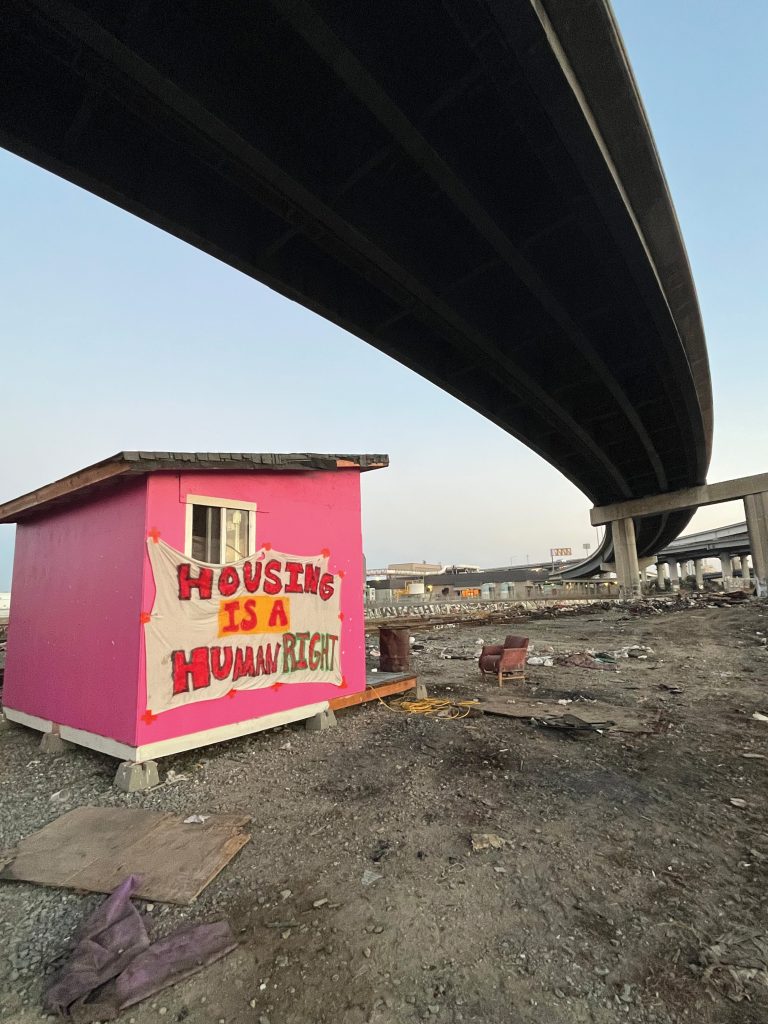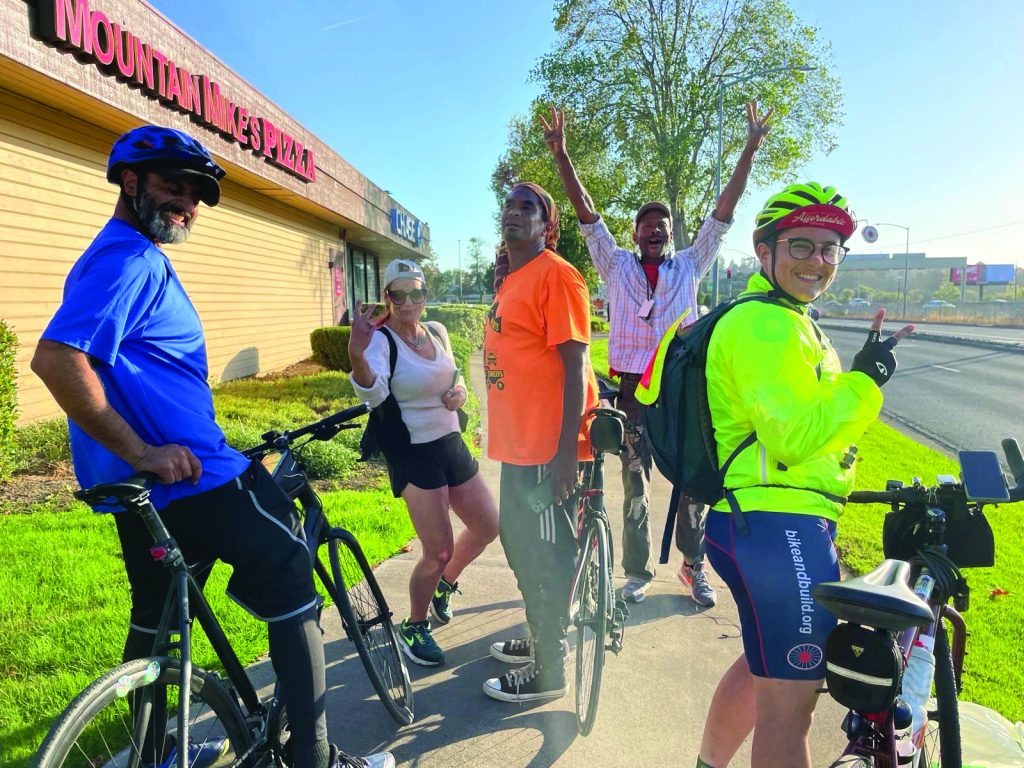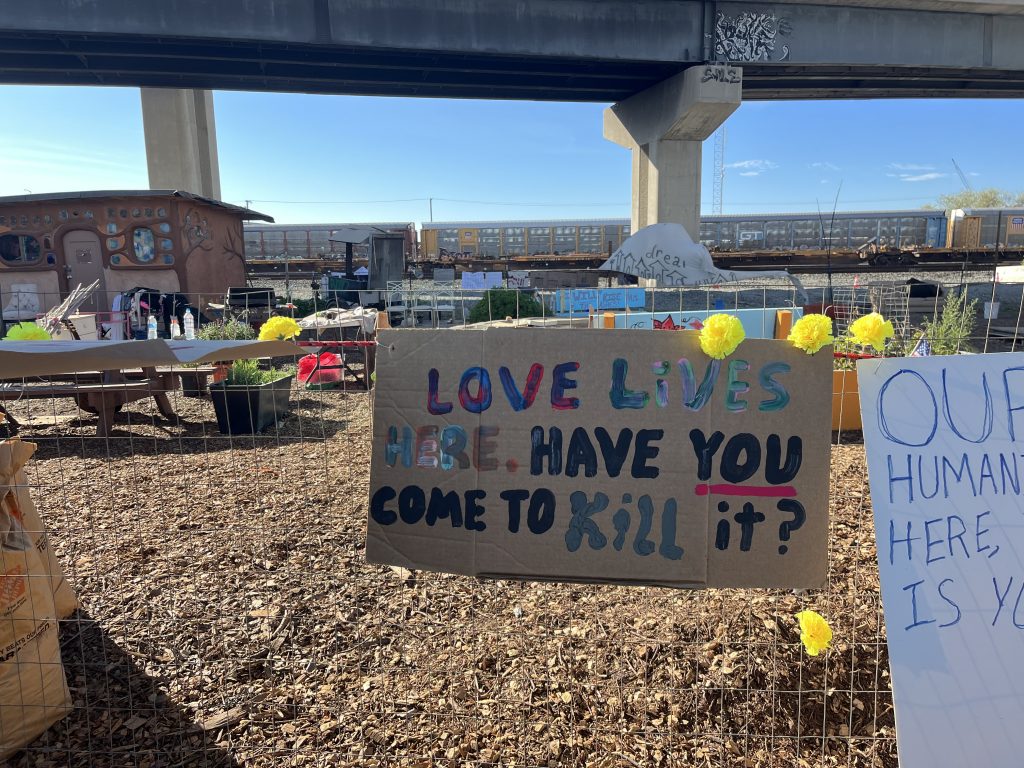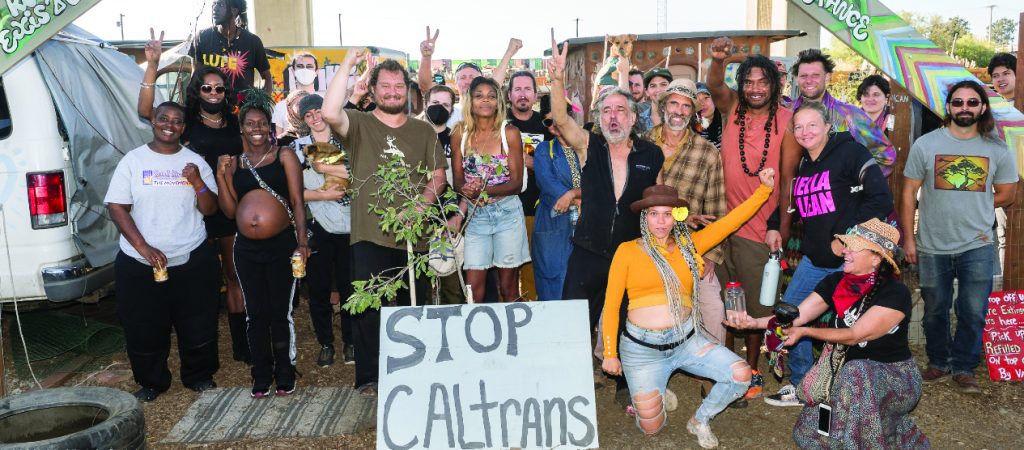
The highly anticipated eviction of the Wood Street encampment community began in early September and continued throughout the month. On the days the sweep took place, scores of day laborers arrived around 7:00 a.m. and began their work: tearing into tiny houses, self-built structures, and vehicle homes. They pulled residents’ belongings out and threw them into piles, demolishing the structures with heavy machines. Under the supervision of CHP and Caltrans management, workers swarmed dwellings as residents wove in and out, trying to save their most important possessions. Some days they gave people time and space to pack up, occasionally agreeing to let an individual stay in their home one night longer. Other days they moved quickly and recklessly—in one instance forklifting a resident’s home over the train tracks as an Amtrak passenger train barreled through. The train crashed into the dwelling—an old box truck—at full speed, tearing the prongs off of the forklift and stalling the train. (No serious injuries have been reported.)
The sweep comes after federal judge William Orrick ruled in late August that Caltrans could move forward with clearing the encampment, much of which sits on its land. Caltrans posted the encampment for eviction after a large fire in the area. But the sweep had been delayed the previous month, when 29 Wood Street residents won a Temporary Restraining Order (TRO) against the agency—naming many elected officials, including Governor Gavin Newsom—on the grounds that the state would be putting them in danger by evicting them with nowhere to go. The judge ordered Caltrans to work with the City of Oakland and Alameda County to find shelter for Wood Street residents. Ultimately, he permitted them to move forward with the sweep after they identified 40 shelter beds within the city.
The Wood Street community has grown steadily over the last 11 years. Home to over 200 people, it sits on land owned by multiple jurisdictions, including Caltrans, the City of Oakland, railroad companies, and private owners. Its large size allows it to function like a miniature city: spanning 25 city blocks, Wood Street has neighborhood-like communities where people support and look out for one another. It is covered in artwork. Elaborate graffiti murals adorn the cement pillars that support the network of highways above. Sculptures and paintings can be found outside people’s dwellings, which wind around each other like an intricate maze. Each section of the community has a unique feeling that reflects the needs and interests of its inhabitants.

By the end of September, a large chunk of the encampment has been demolished, the structures removed and murals power-washed away. The third and final phase of the Caltrans sweep is scheduled to take place during the first weeks of October. The loss of community is immense for former residents, some of whom lived at Wood Street for the better part of a decade. The impact of the sweep is already being felt throughout the City of Oakland as well: displaced Wood Street residents for whom there was no adequate, accessible shelter have started to move into nearby neighborhoods. Some of these satellite encampments have already been posted for eviction, leaving residents no time to establish a sense of stability.
Despite the gravity of the Caltrans sweep, a large and thriving community remains on the parcels of land that surround the agency’s property. The Wood Street Commons, for example, is a section of the encampment that sits on city-owned land. Using the phrase “homeless helping homeless,” residents are actively working to meet the needs of their community, and calling on government leaders to utilize public land for public good. At the beginning of October, they organized a bike ride to Sacramento to meet with elected officials and to rally in front of the capitol to raise awareness about sweeps and the need for long-term, accessible solutions. They are fundraising online here.
Below are statements from just a few Wood Street residents. Street Spirit asked them all the same two questions: What do you think your neighbors should know about Wood Street? And, now that the sweep has begun, what do you think people need? Their answers have been lightly edited and condensed.
***
John Janosko, Wood Street resident 8 years
First I would just like the wider community to know that the reason why the conditions down on Wood Street are the way they are is that the people of Wood Street were sent down here by different officials, like the Oakland Police told me and other unhoused people in North Oakland to come down here, told us come down to Wood Street, that we’d have a safe place to live, people wouldn’t bother us, that this could be our community and stuff. Once the migration started and Wood Street started filling up, there were never any resources provided for the people down here: No electricity, no running water, also no trash removal service. So you think that in any neighborhood in America, if they were to lose those three vital resources, what would happen? That’s exactly what happened down here. Trash removal service, there was nowhere for anyone to put trash. We had to find ways to dispose of that on our own. In the back there were no portapotties. Caltrans or the City of Oakland never put portapotties in the back. And in the back there were about 300 people living back there at one time, and they never were allotted any portapotties. I think it’s very important that people see the other side of the story and understand why things are the way they are. It wasn’t because just primarily because of the people of Wood Street, it was because we weren’t given the resources to be able to take care of ourselves in that way.

People need land. Or a place to exist or be. Things are being done backwards: so you have evictions going and the city is telling you you don’t have any shelter beds, you only have ten Tuff Shed cabins left and the alternative is going to St. Vincent de Paul, which is a dorm-style [shelter]. So you come in at 6:30 pm and you have to leave by 6:30 am and you’re wandering the streets all day. People need a place to exist, be it temporary housing, of course permanent housing, but right now since none of that is available they need a piece of land where they can recreate their community. And we need the resources to come down [and be] directly available—to get people into housing, directly get them into mental health resources. People get lost in the system all the time and we need people to be on the front lines with them working from this day until they get housed.
Mavin Carter-Griffin, Wood Street resident 11 years
There’s some kind of unseen enemy behind the scenes, I’m guessing it’s gentrification. There’s developers everywhere. I can’t put my finger on it other than [that]. We’re not looking for the heads on sticks kind of thing, we just want to have our chance. This land, we got it. I’m sorry about your luck but we got it. If you want to develop your mammoth tycoon apartment buildings and lofts, wait ten years and partner with us. We have the opportunity right here right now to lift all unhoused people. And they have to treat the condition and respect the people. That’s something they haven’t done yet, they’re still not looking at it that way. We’re under attack. And yeah we could probably do this better but it’s really hard to catch up with the onslaught of a continually growing crisis. Our population has grown and they say they’ve put people in housing, but it’s not the stable kind of housing that we want. We want choices in housing and we want to innovate housing. We want portable and affordable. We want to be able to navigate. We also want a guide. People should treat us like a demographic and consumers rather than like diseases and fucked up people. We are the runoff from systemic failures and fuckups since slavery and we’re tired. Women need support out here, the LGBT need support out here, Black people need support, everybody needs support to create a really unique neighborhood. This place could be a benefit, not just to Oakland but all of California. We have what it takes to fix this. They need to hire more unhoused people and listen to us when we give out input. We are experts in homelessness.
Opportunity opportunity opportunity, and to be more socialized. We need activity down here. We need to have different types of things and we need to have it structured, and I need to be the design director. Give me two years, let me pick my team amongst us, and let’s really pull this together. Everybody. Because it’s any random citizen that can become homeless, and it’s going to take every random citizen to figure this out. And we need publicity. We need good stories, because it’s a good fight.
H3O, Wood Street resident 4 years
We’re just normal people who have lives just like you: welders, doctors, security guards, rappers, you don’t even know. Good people that live here took this place and brought it to a place where they called it home. They made it a safe place to go where we wouldn’t be fucked with on the streets and get our shit taken. Everybody that lives here is family. We all know each other, we all say hi to each other, we all look out for each other. We have people that basically stand their ground to stop people from bringing stolen cars, trash… just to make sure shit be cleaned up or not be even more trashed. If we didn’t have no security here this place would have been worse than what it was. These fires? I don’t know. We hate the fires. We start bonfires but we’re not the ones who will set another person’s shit on fire. We barely got somewhere to go.I’m not mad at the workers that’s working for Caltrans, I’m mad at the company. Doing out of pocket shit. Taking people’s stuff that they worked hard for. Damn near 68 percent of my shit, my tools, my shit that I basically worked for, that I need to work, is gone.

They’re telling us they have four-point-something million dollars to fix this, to do this, to build these little box houses and cage us normal people. We’re normal people just like everybody else. Yeah there’s some people out here who do drugs, but I’m not the type of person that would do drugs. I’m the type of person who likes to work. You’re not going to tell me I have to go to a drug program to get off the streets, to live in a house with another person and have rules and regulations and have a curfew, and be living in a small box. I’m 6’6, I’m not trying to live in a small box with another person. The ones that’s here, we want to get off the streets. We don’t want to be staying in these ratty-ass complexes. It’s like taking a rat and putting it in a cage and leaving it there, that’s what they want us to do. They want to cage us in. What would be better is giving people an opportunity to reset their lives and give them something to live in, to have a regular normal life and not feel like they’re being caged in. We all are equal but not. They look at homeless people like we’re a disease or something, but we’re not.
Phil, Wood Street resident 2 years
A concept that I learned here at Wood Street is there’s an infinite amount of ways that everything can improve for everyone. The knee jerk reaction is, well the opposite is true too. But it’s like yeah we all know that. That’s what you hear every day from everyone. And so I’m trying to add an element of hope to my own life for other people. I had a friend once who used to say things ripple. Specifically here, what we do is important. Wood Street to me came to represent the purest form of freedom that I’ve ever really seen in my life in a collective sense. It led to incredibly positive things for me in terms of my ability to make art and music, to have some breakthroughs, some time to heal. I feel like it was really good for me, and it specifically has to do with the people. Whenever you go to a place, it’s the people that make the place the place.

It’s good, because everybody wants the same stuff. Everybody needs clothes, needs food, needs friends, needs a place to put their head, you know. There’s universal things that tie us together. The outside world I think could look in and just know that it’s possible…so I think going forward we need to be more positive. Because there really is provision. Some people are getting rooms. Volunteers are bringing food. The social setting, people will support each other. It’s a beautiful thing.
There’s a spectrum of people on the street. There’s all different kinds of people out here with different needs. I think the Bay Area is really good about meeting those needs and having a diverse set of resources. I’ve seen stuff here in Oakland that I haven’t seen anywhere else. And it’s cool and gives you hope, because it ripples, remember. Sometimes people just need to be heard too. Especially out on the street.
Purple Beard, Wood Street resident 4 years
Wood Street and the people who live here, there’s a reputation I guess, an air that people who have never been back here feel, and that brings it into existence. [But] I’ve never felt freer than back here. Freer. I mean free, you know? Of expression, of pretty much anything you want to do as long as it doesn’t hurt anybody. Most people nowadays are one paycheck away. Please don’t look down on somebody, because nobody here that I know would laugh in a mean way at their circumstance if it was reversed. I hate bullies. But the state’s being a bully. They didn’t need this land for a million years until now. [The workers] are the fingers of the palm that is Gavin Newsom, or whoever. And because they are making light of people’s circumstances and being generally really disrespectful, look what happened [the train crash]. This place has spirits. And I can’t explain it enough but it’s so real. I’ve seen it.
People need understanding. They need understanding from everybody else. And then appropriate action to be taken when it’s not colored by judgment. People are people and if it was reversed, like I said, nobody here would clown them.
Alastair Boone is the Director of Street Spirit.
